13. Conserving Active Matter in Contemporary Design
- Jessica Walthew
- Sarah Barack
Cooper Hewitt, Smithsonian Design Museum houses the United States’ national collection of design, which ranges across all media, encompassing graphic and textile design, decorative arts, product prototypes, process materials, and archives. The museum’s triennial exhibitions celebrate designers working at the cutting edge of their disciplines. The 2019 nature-themed Triennial inaugurated the first co-organized execution, with Cooper Hewitt partnering with Cube design museum in Kerkrade, the Netherlands, for a simultaneous display. The exhibition aligned well with the museum’s recently enacted strategic plan, which envisions the museum as both a repository of historic collections and an active platform for contemporary design.
The use of “active” materials in contemporary design creates challenges for exhibiting and maintaining complex works in museums. “Active matter” has been the theme of several research projects across the globe examining responsive materials, and forms of material and conceptual “activity” inherent in art and design.1 While interpretations of this phrase vary, this triennial exhibition presented projects ranging from truly live organisms and plants to synthetic media designed to react to its local environment. This paper considers this range of “active” media and its impact on conservation staff and practices. The featured case studies notably illuminated biases inherent to conservation practice and challenged the museum’s conservators to accommodate and even facilitate uncertainty and change to display designers’ innovative works. Reconceptualizing these works as process-oriented iterations that are constructed and maintained through networks of feedback loops has shifted conservation approaches away from those typical for static objects, where maintaining stasis (limiting change) is usually the explicit goal.
The most challenging projects were examples of speculative design—proposals that examine contemporary problems and provoke visitors with visions for futuristic outcomes.2 The projects featured bioengineered and bioresponsive media (which change rapidly in response to changes in light and temperature), living plants, and microorganisms that were to be exhibited for eight months and required both complex installations and intense maintenance. Other works, though not technically alive, displayed lifelike behaviors and demanded environmental management in a continual feedback loop. Together these works necessitated an interdisciplinary, cohesive approach to their care, and required conservators to interface creatively with colleagues across specialties.
Consistent with the goal of the Triennial, many of the featured designers hoped to exhibit examples of their most recent work, and thus the details of many projects were still being developed during the exhibition planning process. As a result, the specifics of many projects remained unconfirmed until dates very close to the installation. In several cases, the iteration displayed represented an ongoing technological development, with active refinement of the design strategy continuing beyond that iteration—a sort of snapshot of the project as communicated through a bespoke model. Cooper Hewitt’s conservators worked closely with internal staff and the designers to realize their desired visions. This alone required flexibility, adaptability, and frequent communication among stakeholders—greatly eased by digital technologies, given that there were sixty-two international design teams. The following case studies highlight the projects that best capture these evolving challenges.
Case Study: Living Plants
Supporting living plants in three projects involved substantial coordination of parties inside and outside the museum. While one project, Sam Van Aken’s Tree of 40 Fruits (2008–ongoing, fig. 13.1), was sited in the garden and maintained by the museum’s gardener, two other projects were located inside the galleries and required major resource investments from the designers themselves. The Open Agriculture Initiative (OpenAg) team at MIT Media Lab designed Personal Food Computer v.3.0 (2018–ongoing, fig. 13.2), a 3D-printed growing chamber. Sensors track climate variables, and a coded “climate recipe” determines the lighting regimen and controls ventilation. Two of these self-sustaining chambers were displayed with growing hydroponic basil plants, which required maintenance: nutrients were replenished by staff twice weekly, and plants were pruned to prevent them from getting too tall. The designers, who had traveled to the museum for the initial installation to train staff, provided replacement plants when needed.
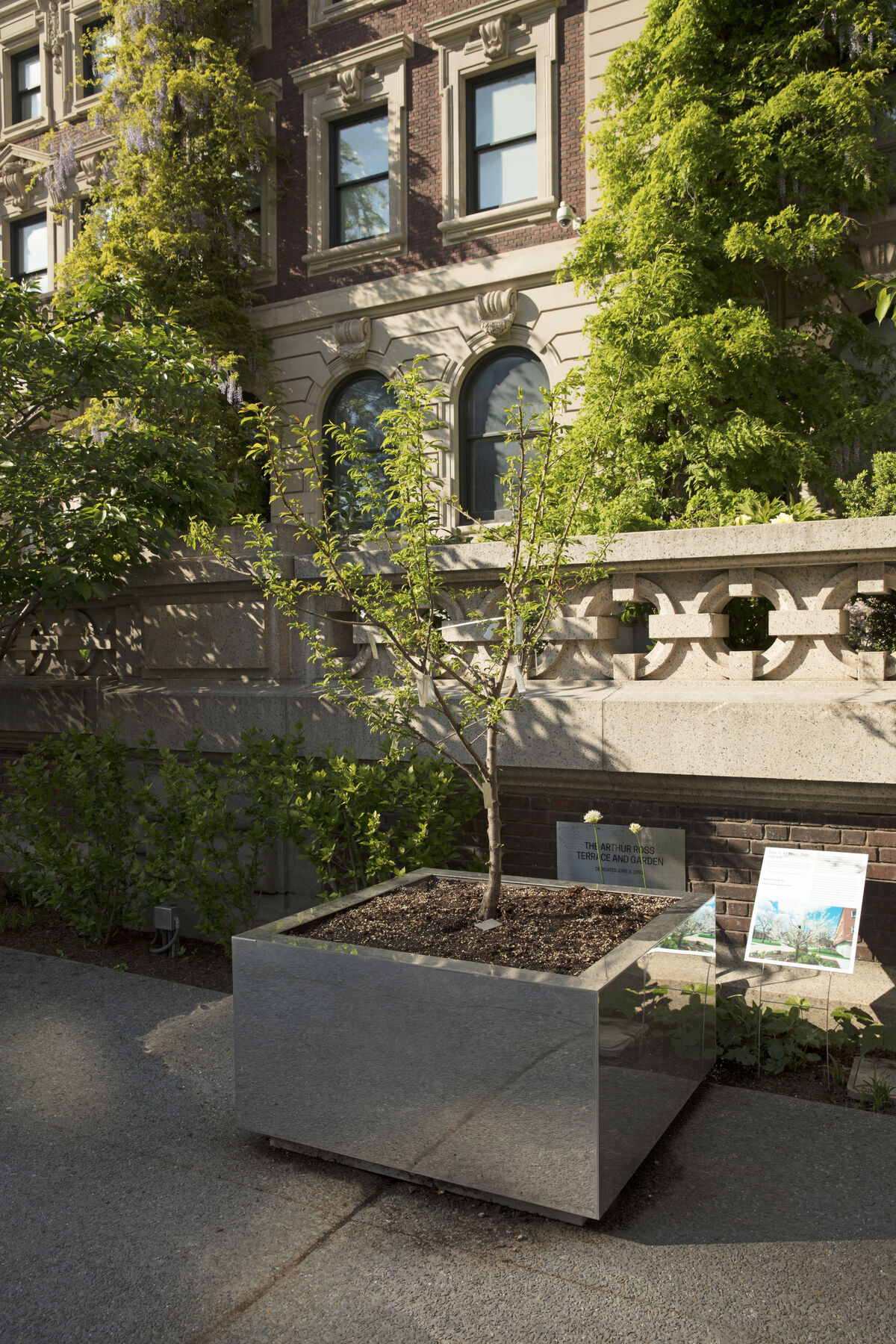 Figure 13.1
Figure 13.1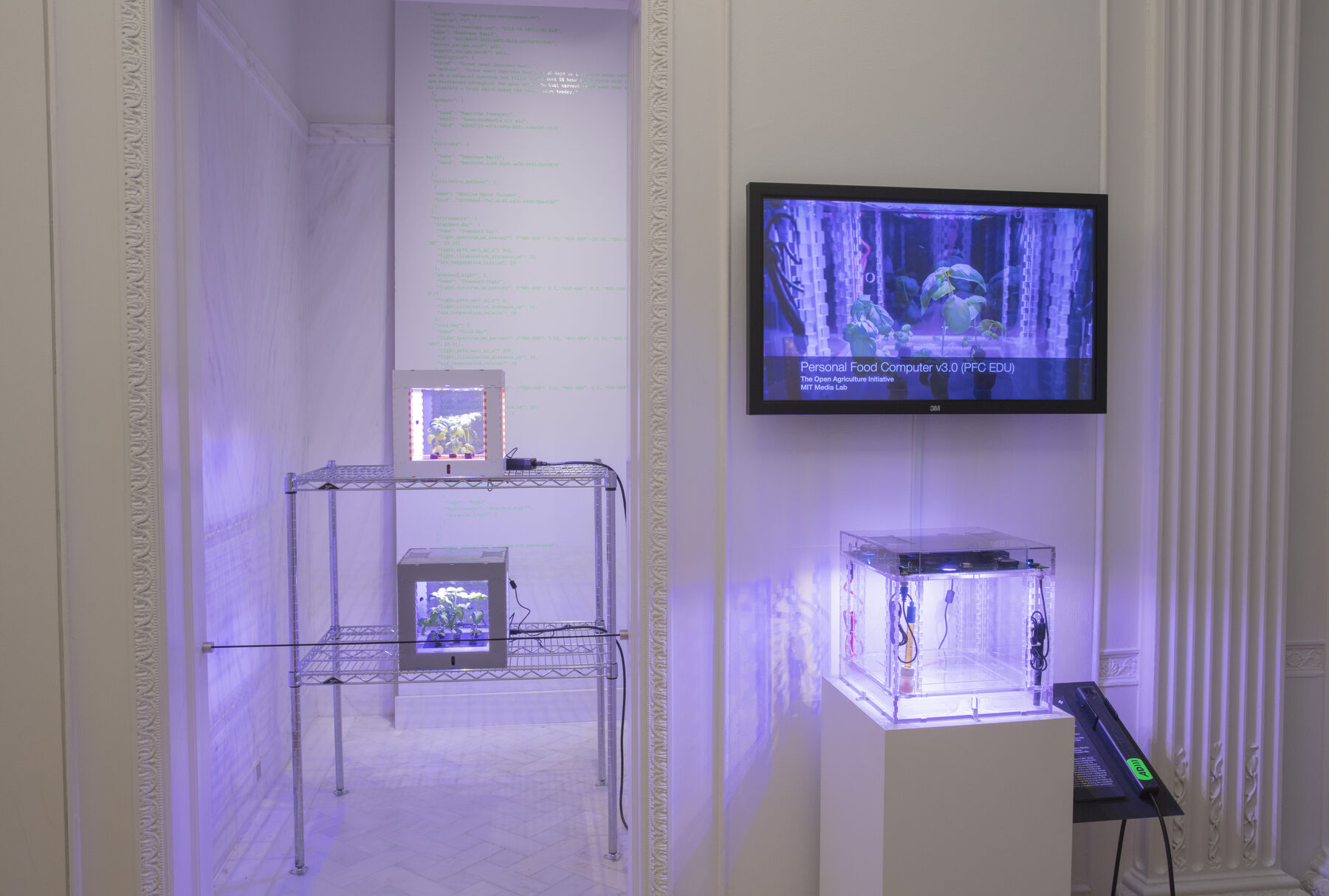 Figure 13.2
Figure 13.2Plant Properties (2016–ongoing, fig. 13.3) by Kennedy Violich Architects and the Strano Research Group at MIT likewise required plant replacements, but on a much more intense schedule. This work imagines how bioluminescent plants could be integrated into future architectural settings so as to reduce our society’s dependency on electricity. The functional architectural model included living watercress plants along with complex lighting and irrigation systems. Due to the highly specialized plant treatment conducted at MIT to create the luminescing watercress, representatives from the lab traveled weekly to provide and install new plants. The success of this display, as with Personal Food Computer v.3.0, relied on active collaboration between internal museum staff and the external design studios, and a significant time investment. While replacement was a viable strategy in both cases, communication took on greater significance to coordinate ongoing intervention in the projects.
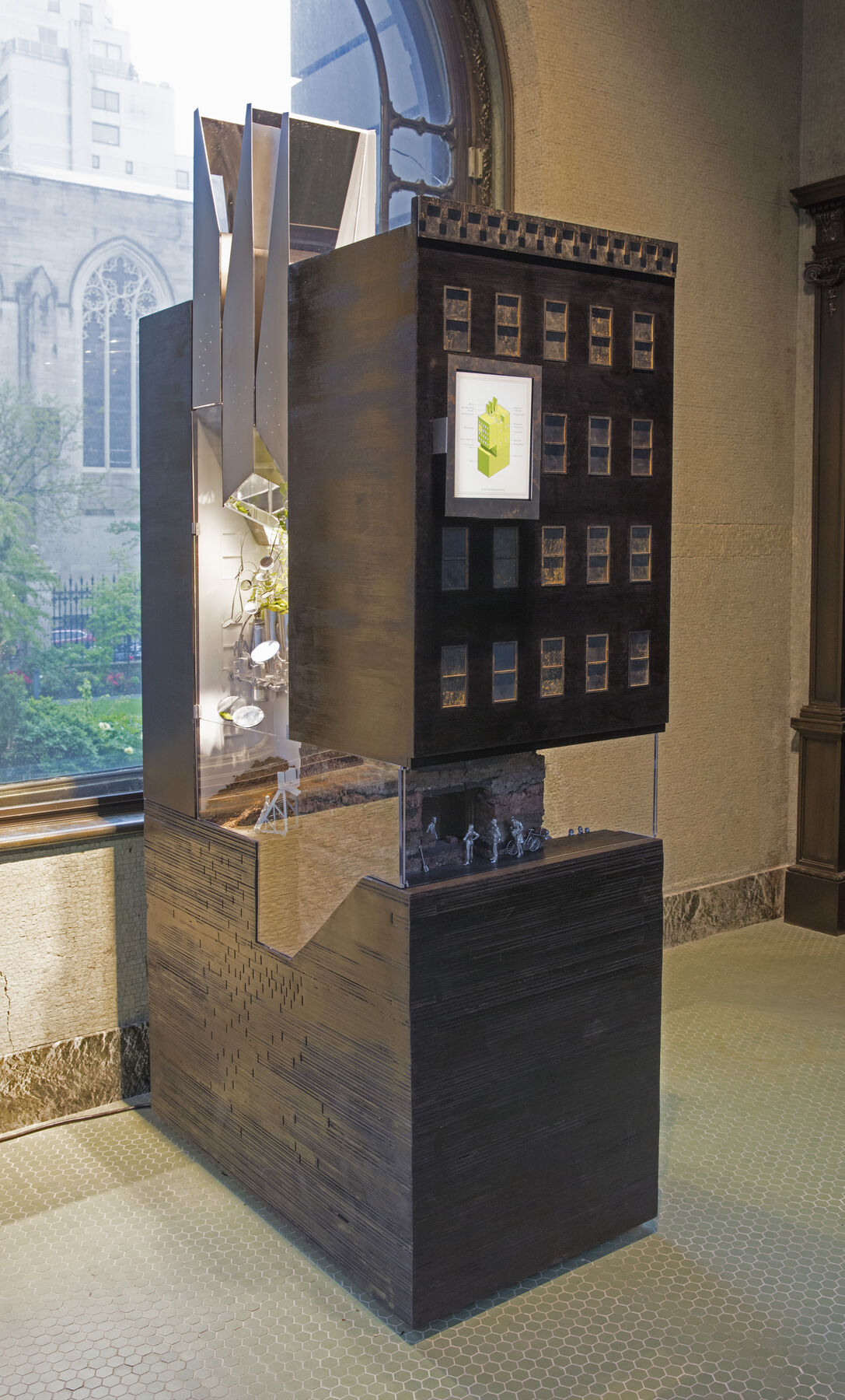 Figure 13.3
Figure 13.3Case Study: Living Cultures
Living cell cultures were critical components of two Triennial projects: Teresa van Dongen’s Electric Life (2018, fig. 13.4) and Oron Catts and Ionat Zurr’s BioMess (2018–ongoing, fig. 13.5). Close coordination with the designers and their domestic scientific collaborators ensured that live cultures could be used, either transported across international borders or sourced domestically. In each case the bacteria or cultures were nonpathogenic, but still occasioned special handling concerns. Unlike a typical lamp that relies on traditional alternating current, the living lamp in Electric Life is powered by an aqueous anaerobic bacterial culture housed at its center. Prior to assembly, the bacterial culture required cultivation for more than one week until it was robust enough to generate the required current. With the designer unable to personally attend the installation, the conservators quickly adapted to the roles of ad hoc bacteriologists and electricians in close consultation with her. Continued feeding and care of the culture proceeded in a similar fashion, with conservators as proxies for the designer, as had been the case at a previous installation of the work at the Centre Pompidou, Paris, in spring 2019.
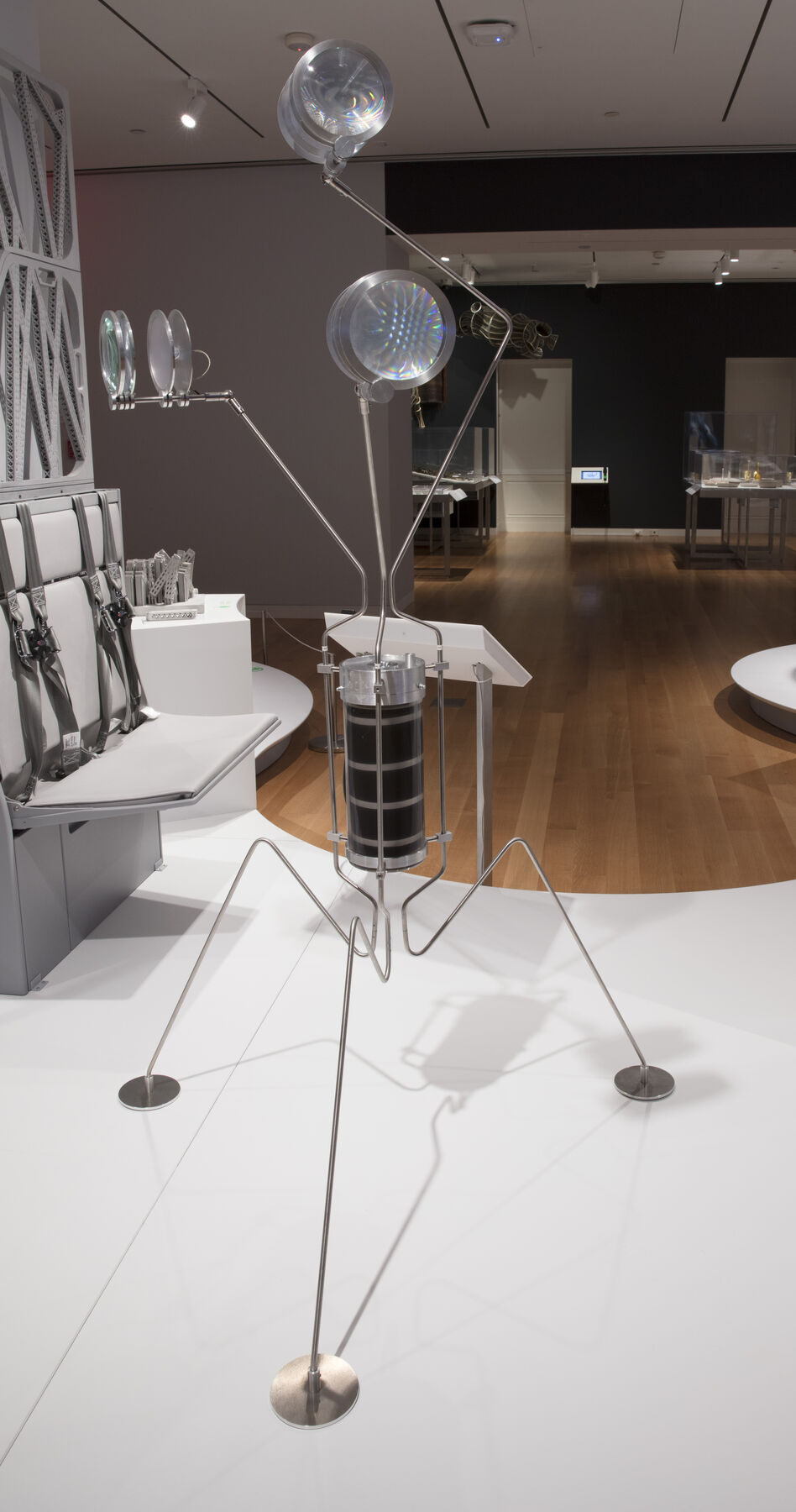 Figure 13.4
Figure 13.4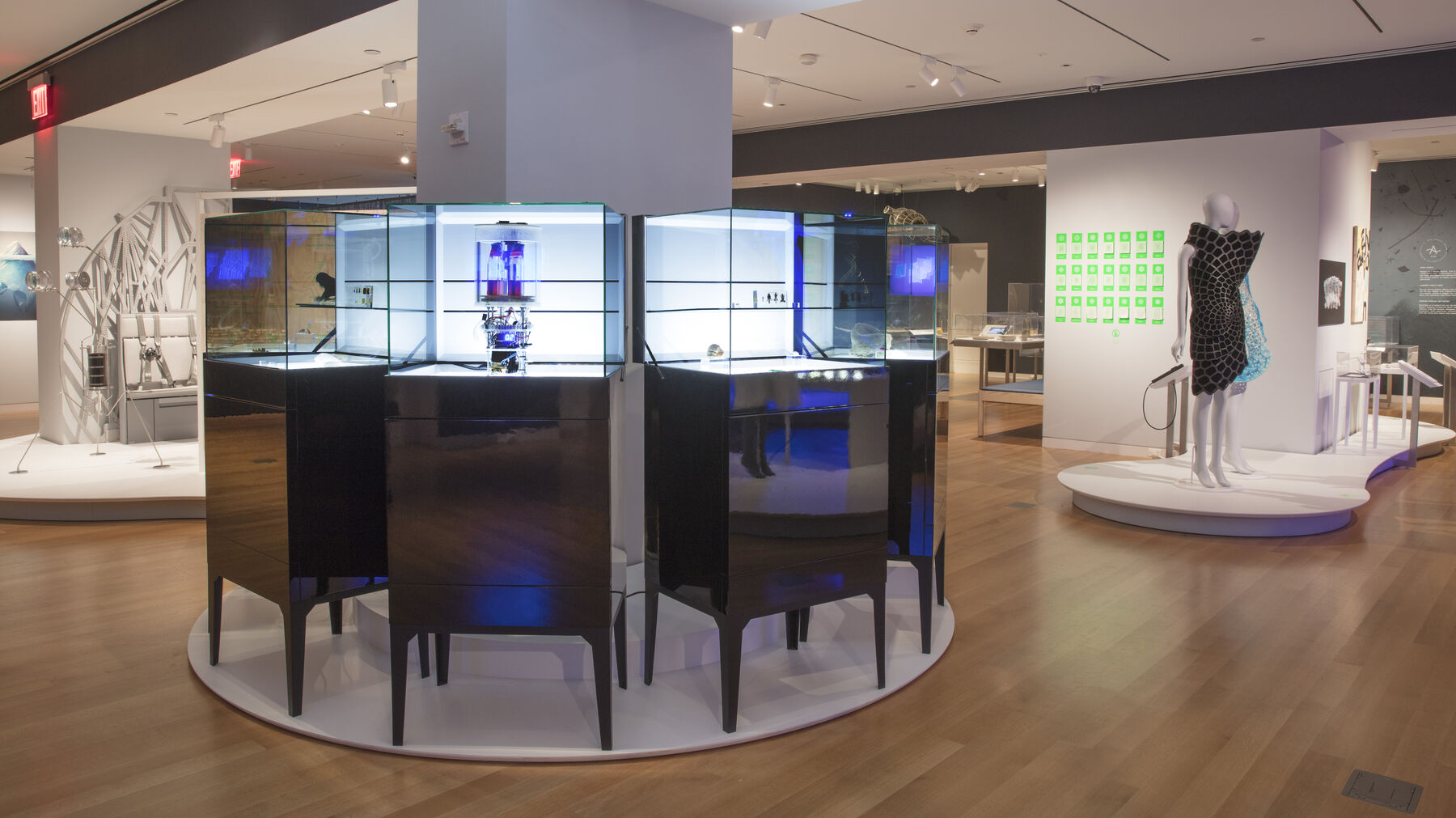 Figure 13.5
Figure 13.5BioMess also contains living cells, in this case a hybridoma culture (fig. 13.6) displayed inside a bioreactor, alongside specimens borrowed from the Smithsonian National Museum of Natural History and shown in backlit luxury display cases. The project probes the human fixation with creating new life forms by questioning what is recognized as life. The natural history specimens may be considered “life,” but the only actual living matter—the hybridoma cells—is abstracted, completely devoid of environmental context. Made by humans, the hybridoma cells are contained in and dependent on a technological body, namely a bioreactor. Two bottles containing bright pink live cell cultures were installed by the designer but were not expected to live for the duration of the exhibition without activating the bioreactor, which the museum could not manage. Museum conservators and curators, along with the designers, agreed that if and when the color of the medium indicated that the cells had died, the conservators would remove and replace them with identical bottles, simulating the culture with an inert liquid. This decision was initiated following conversations with Catts during the installation, when he suggested this step. Though this request appeared an aggressive intervention, the staff felt it acceptable after considerable discussion, so that the display would not shift in appearance without ample public didactics. Further, as the cultures would by then be dead, exhibiting a replacement liquid would have the same net result as maintaining the original media—both would contain nonliving matter.
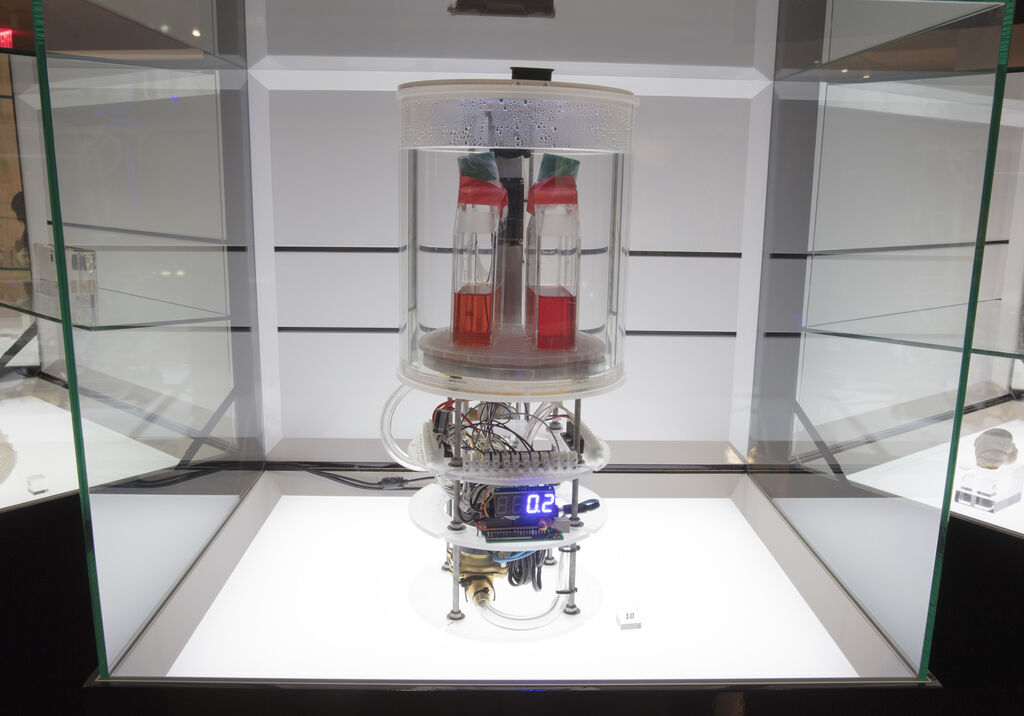 Figure 13.6
Figure 13.6Following successful installations, the conservators grappled with both logistical concerns—safely discarding the BioMess culture; the proper feeding schedule for Electric Life—and others more philosophical in nature. For instance, is it ethical to obtain living cells but not provide them with the nourishment they need to thrive? Catts and Zurr have written that their work with dependent “semi-living” cultures broaches but does not intend to resolve these concerns. The works are meant to provoke viewers to examine their own unsettled and ambiguous feelings with regard to what is living and nonliving by presenting them with something in between. In previous works, the designers had involved museum staff and visitors in the rituals of feeding and killing, to contribute to the performance and bring fuller meaning to the works (; ). For Cooper Hewitt’s iteration, the conservators assumed that they would eventually (uncomfortably) play the role of executioners. By the close of the exhibition, however, the cell cultures had not shifted significantly in color, and no replacement media had been required. This surprise left the staff with a sort of ironic understanding of the piece, as it became akin to Schrödinger’s cat. Were the cells still alive or not? With no visible signs of die-off, but yet no means to test, the vials existed with a vague liminal status of possibly living and possibly deceased.
As opposed to a planned one-time intervention, conservators for Electric Life routinely made decisions that directly impacted the health of the bacteria in order to keep the lamp brightly lit. Van Dongen aims to engage owners of her lamps in intimacy through caretaking, while seeing the natural facets of her lamps as “something that exists on its own, in a way” ().3 Although museum visitors were not consulted, their presumed experiences weighed in on decision making, as did the appearance of the displays. As it turned out, the lamp’s intensity waxed and waned as the bacterial culture changed over time, but these changes were imperceptible to the public.
Case Study: Environmental Passivity/Activity?
The final case studies present simulations of nature in two contrasting artificial environments, one frozen in time and the other ever-changing. Terreform ONE’s Monarch Sanctuary (2018–ongoing, fig. 13.7) proposes cladding a skyscraper in an architectural envelope that supports all phases of the butterfly life cycle with adequate heat, moisture, habitat, and food sources. Modern building construction could one day support biodiversity by providing alternate habitats for endangered species. Design studio mischer’traxler’s Curiosity Cloud (2015–19, fig. 13.8) is an immersive environment featuring more than one hundred handblown glass bulbs, each outfitted with LED lights, a motor, and a model insect (fig. 13.9). Thermal sensors respond to gallery visitors moving among the pendants: sections of insects turn on and fly around inside the lit bulbs. The piece captures the magic and beauty of the natural world through synthetic media and fosters larger discussions on nature and our contemporary relationship to it. Both installations actually refer to acts of conservation, in this case of the natural world. The architects plan to eventually realize Monarch Sanctuary in New York, and are collaborating with butterfly keepers at the American Museum of Natural History to understand the optimal synthetic habitat. In Curiosity Cloud, the model insect species were carefully researched and crafted to create a simulation uniting extinct, critically endangered, commonly occurring, and recently discovered species that could never coexist in the real world, highlighting the fragility and mutability of “nature” in the Anthropocene (, 34–35).4
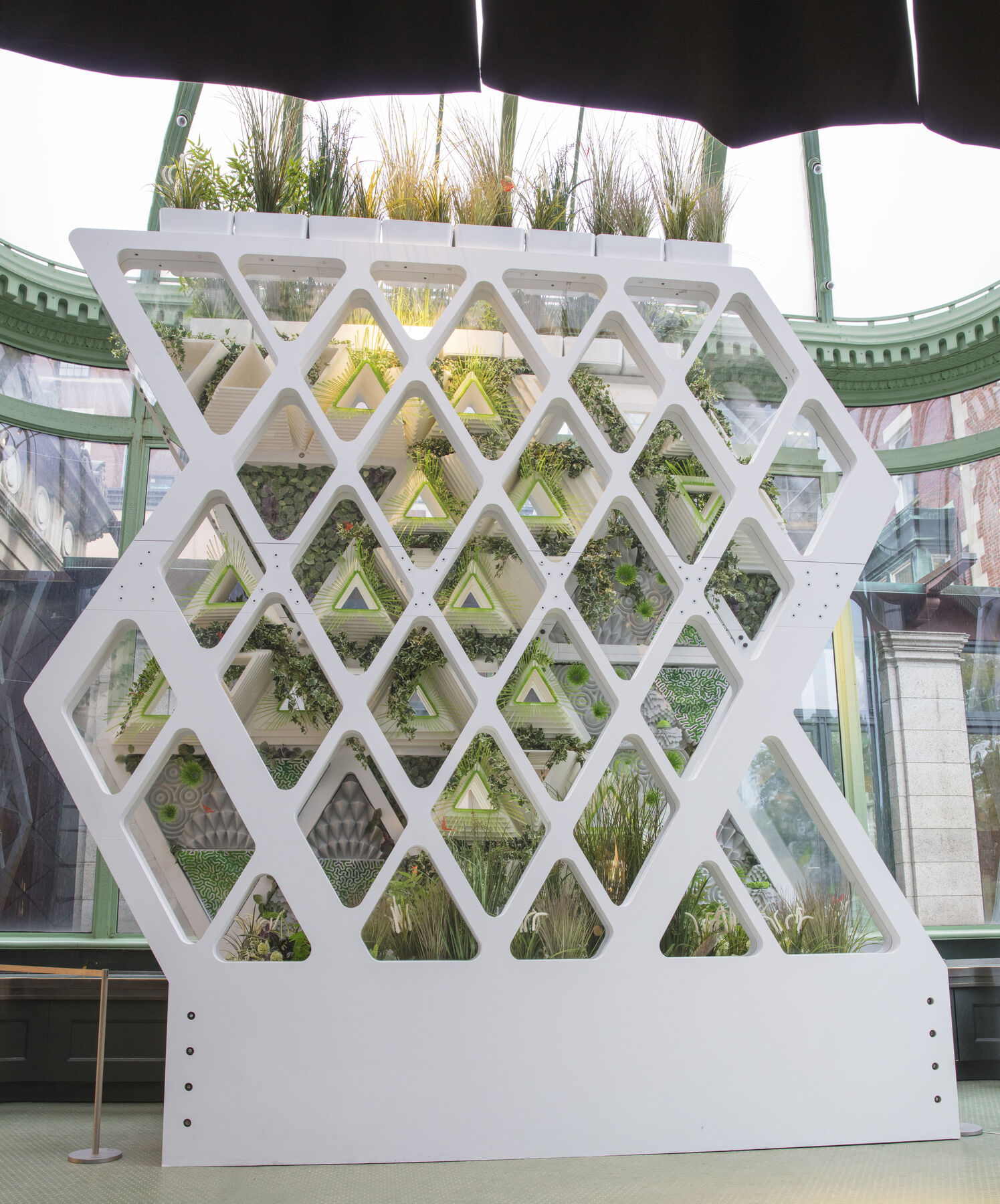 Figure 13.7
Figure 13.7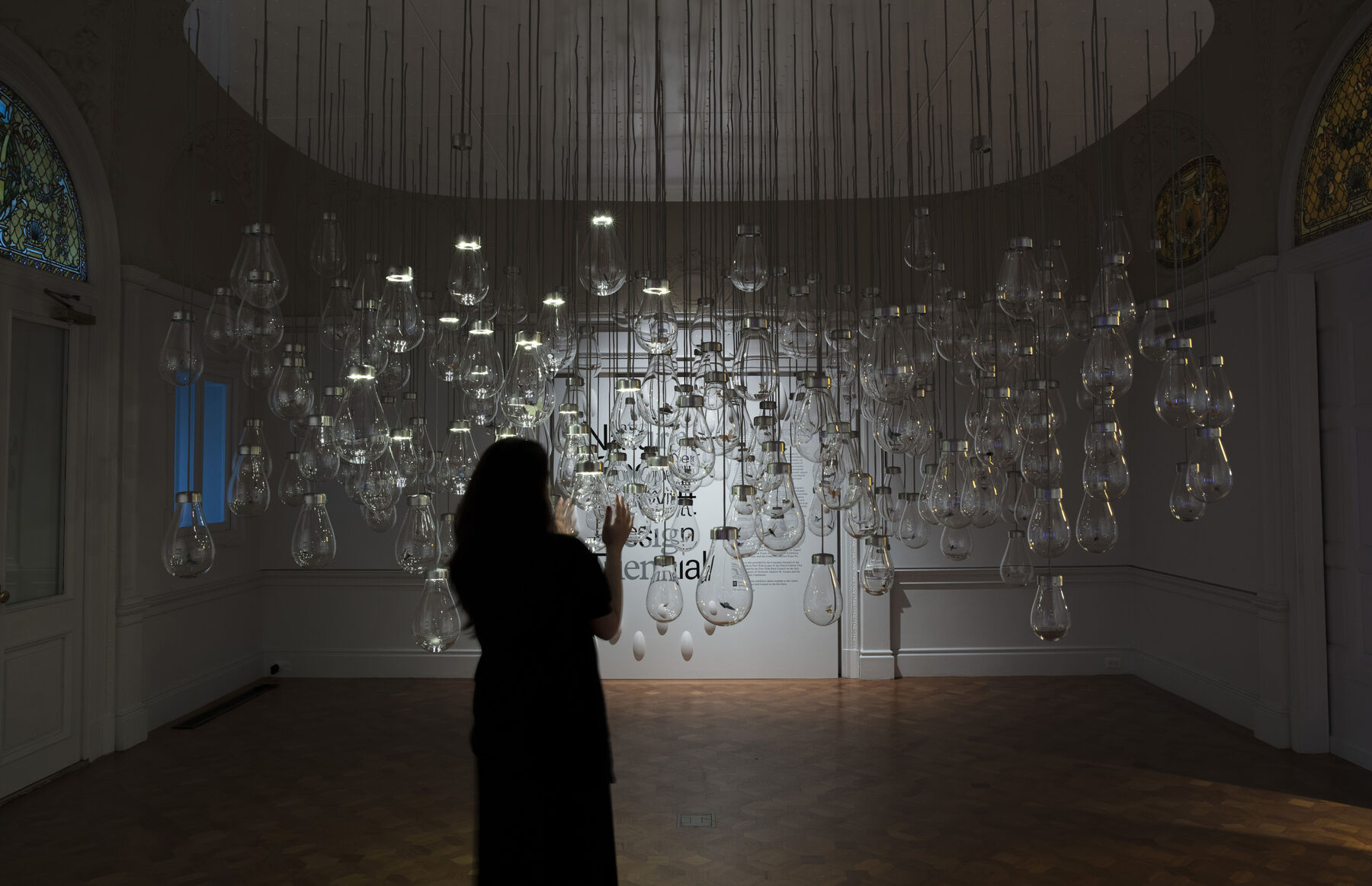 Figure 13.8
Figure 13.8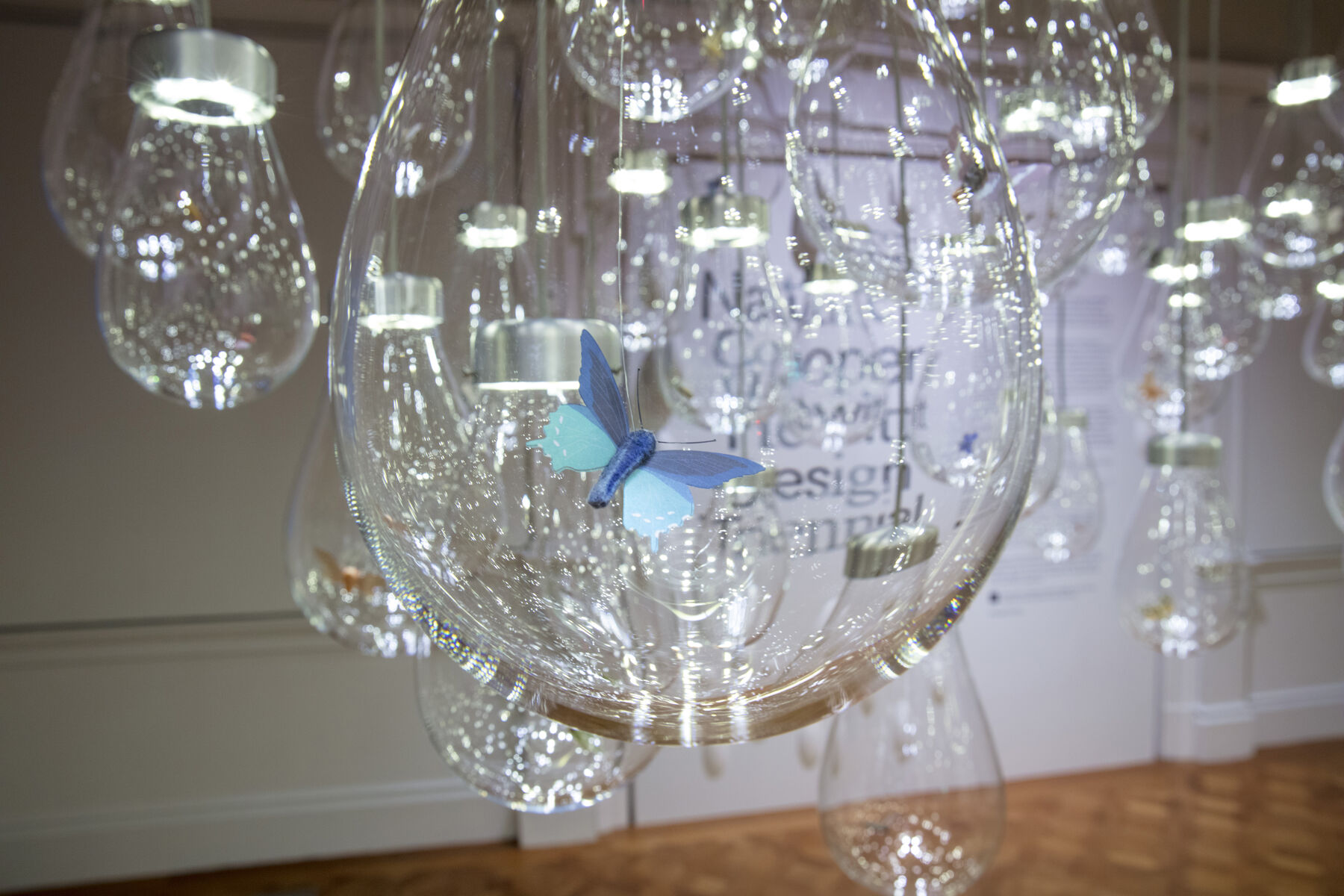 Figure 13.9
Figure 13.9Exhibition design concerns dictated the staging of each project in specific gallery locations, though in each case unavoidable localized environmental conditions influenced the function and performance of the work. While one may ordinarily perceive the museum environment as a passive player, in these two cases it was the source of major conservation concerns. Monarch Sanctuary was originally planned as a fully functional model containing live milkweed and butterflies in the museum’s Conservatory, which in itself posed several challenges. The Conservatory lacks effective climate control, and so additional mechanical systems inside the model would be required. The museum staff is not trained to care for live butterflies, and the release of mature butterflies and introduction of new ones raised ethical concerns. Staff expressed ethical qualms about treating butterflies as disposable. Butterflies are attractive and popular (as insects go), potentially opening the museum up to public criticism, and also the sacrifice would undercut the conservation message of the work in a particularly ironic way. Sharing these concerns, the curators and the designers agreed that the museum would display the sanctuary design with simulated (3D-printed) butterflies, reconceptualizing the project’s iteration/instantiation as a model without any functional systems or live inhabitants.
Curiosity Cloud’s complex system requires particular environmental conditions to allow it to respond to visitors’ thermal presence. In this iteration, it was customized for Cooper Hewitt’s gallery space and prominently sited at the exhibition entrance. Gallery temperature required tight control to avoid tripping the thermal sensors meant to respond only to actual visitors’ bodies. When no sensors are activated (that is, when the temperature is below the 23.5ºC “action threshold”), the program activates “allure mode,” illuminating just a few bulbs at a time to tempt visitors into the gallery. The precariously balanced system could be viewed as a complex interaction between the human actors (visitors, designers, museum staff) and the electronic elements in the constructed environment.
The environment itself, usually invisible except to collections preservation specialists (as numbers or graphs on data loggers), further assumed status as an active player in the network. When the room became too warm, all the insects were activated, preventing the piece from being experienced as designed. In response, museum staff (conservators and building engineers) participated in a delicate dance with the display, resetting room temperature controls to levels that would be practical from a visitor and gallery perspective but would not inappropriately activate the piece. Exhibition design elements (stanchions to direct visitor flow) also contributed to the work’s performance. The designers, working remotely from Austria, modified the code that controlled the sensors and motors, and sent an additional room sensor midway through the exhibition to improve calibration. In this way, multiple actors massaged the installation throughout the exhibition’s run, caring for the simulated insects with almost as much attention as they would give living organisms.
Discussion and Conclusions
The nature-themed Design Triennial featured cutting-edge designs that engaged with, manipulated, simulated, and re-created the natural world. Installations included micro- to macro-ecology and digitally interactive elements, encouraging the museum’s conservators to reconceptualize conservation goals and approaches to working with designers. Considering the complexities of the works early in the planning process, the conservators began to (reflexively) categorize projects—living/nonliving, inactive/active, reactive/interactive—in other words, high maintenance versus low maintenance for conservation. The department further dissected internal conservation assumptions and strategized around proactive versus reactive approaches to planning, installation, and ongoing maintenance. With the designers continually refining their own projects, advance preparation proved challenging. Flexibility and collaborative approaches were key to success, along with clear communications among all parties. Reflecting on the works now, these lines of communication might be considered inextricable links between all stakeholders and components, who together created an interwoven network operating within the boundaries of the museum environment. Much as actor network theory (ANT, see ; ) activates nonliving components of a system, the exhibits both reacted to and acted on all engaged parties, regardless of their initial classification as synthetic or authentic biology.
ANT and other frameworks from material culture studies that seek to understand complex interactions between objects, people, and meanings have been employed infrequently with regard to conservation decision making (). However, for many years, conservators have embraced their roles as intermediaries and interpreters, transmitting and translating information between objects and various parties (curators, scholars, artists, students, the public) and serving as advocates for the typically nonverbal objects. In the Design Triennial, concerns for safe display went beyond the customary packing and shipping, mount making, and environmental guidelines, extending conservation’s reach into truly intimate interaction with the materiality of the works on view. Instead of focusing on concrete objects, envisioning the works in the Triennial as systems or networks allowed further progression of the idea of managing change over the duration of the exhibition: as feedback builds in a network, the footprint shifts, the players react, and new paths are formed.
What Does It Matter If the Matter Is Active?
The instinct to classify the works as living versus nonliving, digital versus analog, or according to other binaries did not serve us well in understanding their full complexity. While natural/artificial and analog/digital are often understood as in opposition, many works in the Triennial specifically challenged such dichotomies by blurring boundaries. Designers of active matter often work in explicitly transdisciplinary or anti-disciplinary modes. As Danny Hillis has argued regarding today’s era, pulling from anthropological theory, “Entanglement artifacts are simultaneously artificial and natural; they are both made and born. In the Age of Entanglement, the distinction has little significance” (; ).
As conservators working with these highly complex installations, more boundaries began to blur, these in terms of responsibility: between those in charge of creating the works, those delimiting their boundaries, and those maintaining them (in fact, participating intimately in their making and their meaning). It is indeed an interesting coincidence that the work of conservators is often described in the same terms as the fields of bioart or active matter: at the intersection of art and science. Does the distinction between these arenas retain significance? Perhaps only in reevaluating conservation’s attempts to engage in scientific, “objective” decision making. In these case studies, there was no “objective” path forward that could have been determined in advance. With so many variables in flux, and actors involved, it was at most times impossible to predict the course of an installation. Works transgressing boundaries between hardware, software, and “wetware” certainly bristle against traditional divisions of museum labor.5 While conservation and A/V tech sometimes work together, we had never before collaborated as closely as we did for this exhibition. As Jens Hauser argues, in contemporary biodesign, “synthetic biology is being approached as a discipline in which both top-down and bottom-up approaches, and the virtual and the actual, oscillate” (, 265). Indeed, although conservators attempted predictions and projections to manage change, uncertainty held a much greater role in this exhibition than in typical installations.
Those conserving active matter in contemporary design in a museum context will continue to confront troubling issues of classification. When the works privilege process over representation, how does this change the way we need to conserve them? Neil Leach and other philosophers have already engaged with the provocations of these new media, finding that self-assembling systems push against traditional epistemologies in which forms derive significance from the either hylomorphic (representational, top-down) or morphogenetic (bottom-up, process-oriented) processes that constitute them (, 20–22). Conservators too must wrestle with the philosophical in our decision making. Do we need to actively participate in processes to ensure that the meaning of the work is carried through? What does substitution or simulation of parts do to the meanings of these works? How is disclosure or transparency (conversely, deception) part of the conservation process? It might not matter to visitors that conservators periodically feed the bacteria or replace ailing plants with healthy new ones, but they might be distressed to find out that the hybridoma culture had been replaced with tinted water, essentially Kool-Aid.6
Given that many of the Triennial projects discussed here are part of active research programs, feedback from the exhibition may influence future decisions made by the artists and designers—carrying the feedback loop further outside the museum’s walls and into the future as new networks build. Among conservators of contemporary art, it is still debated to what extent we should consult on or interfere with artists’ practices—acknowledging that conservation interventions can substantially affect both material and meaning of present as well as future works. The projects in the Design Triennial were presented as snapshots, iterations, or test cases, providing valuable data for the designers as processes were negotiated in a new (museum) environment, lacking the controlled conditions of the laboratory or the tidiness of a digital rendering. Yet as conservators, curators, and other museum staff, along with visitors, take part in the enacting of these works, the museum also provides a context where great attention is paid to the controlled framing and staging of the projects. As many of the designers are searching for practical applications for their yet-unrealized concepts, this consideration contextualizes the value of change and iteration. Here change is desirable, encouraged, and an indispensable part of the design process.
Acknowledgments
Thanks to the Cooper Hewitt Triennial team, the designers mentioned in this paper, and especially Larry Silver, Rick Jones, Emily Frank, Andy Wolf, and Emma Mooney, who helped maintain the living exhibits through the duration of the Triennial.
Notes
See . The Matters of Activity group at Humboldt-Universität, Berlin, explores “materials’ own inner activity, . . . a new source of innovative strategies and mechanisms for rethinking the relationship between the analog and the digital and for designing more sustainable and energy-efficient technologies.” See https://www.matters-of-activity.hu-berlin.de/en. Bard Graduate Center’s Conserving Active Matter initiative focuses on conservation, exploring the lenses of materials science, history, philosophy, and Indigenous ontologies “that never made the assumption that matter was inactive.” See https://www.bgc.bard.edu/research-forum/projects/3/cultures-of-conservation. In this paper, the usage incorporates aspects of both of these conceptions as well as conservation’s traditional focus on matter’s change over time. ↩︎
See “Next Nature,” an interview between Michael John Gorman and Koert van Mensvoort (, 49–55). ↩︎
According to the artist’s website: “A future owner of this living light installation will have to feed and nurture it; a bit of tap water with some additional nutrients and a teaspoon of vinegar a week will do. Van Dongen imagines that having to feed and thus take care of Electric Life, could result in a closer relationship between the light installation and its owner” (). ↩︎
The term “Anthropocene” refers to the most recent geological epoch, in which human activity has caused irreversible climatic and environmental shifts. For a concise discussion see https://www.smithsonianmag.com/science-nature/what-is-the-anthropocene-and-are-we-in-it-164801414/. ↩︎
Wetware utilizes cells, protocols, or molecular devices used in synthetic biology, but as applied to art can encompass bioart or the various biotechnological developments highlighted in the Design Triennial (). ↩︎
For comparison, consider the installation of Josh Kline’s Skittles (2014) at the Museum of Modern Art, New York, in 2019, in which authentic (wildly eccentric) recipes were reproduced by conservators and the artist’s studio working together (). ↩︎
Bibliography
- Catts and Zurr 2006
- Catts, Oron, and Ionat Zurr. 2006. “The Tissue Culture and Art Project: The Semi-Living as Agents of Irony.” In Performance and Technology: Practices of Virtual Embodiment and Interactivity, edited by S. Broadhurst and J. Machon, 153–68. London: Palgrave Macmillan.
- Design Indaba 2015
- Design Indaba. 2015. Interview with Teresa van Dongen, April 15, 2015. https://youtu.be/-wukvLHp6Cc.
- Hauser 2018
- Hauser, Jens. 2018. “Art and Agency in Times of Wetware.” Stream 4: https://www.pca-stream.com/en/articles/jens-hauser-art-agency-in-times-of-wetware-107.
- Hillis 2016
- Hillis, Danny. 2016. “The Enlightenment Is Dead, Long Live the Entanglement.” Journal of Design and Science: https://doi.org/10.21428/1a042043.
- Ito 2016
- Ito, Joichi. 2016. “Design and Science.” Journal of Design and Science: https://doi.org/10.21428/f4c68887.
- Latour 1996
- Latour, Bruno. 1996. “On Actor-Network Theory: A Few Clarifications Plus More Than a Few Complications.” Socziale Welt 47:369–81. http://www.bruno-latour.fr/sites/default/files/P-67%20ACTOR-NETWORK.pdf.
- Leach 2017
- Leach, Neil. 2017. “Matter Matters, a Philosophical Preface.” In Active Matter, edited by Skylar Tibbits, 18–23. Cambridge, MA: MIT Press.
- Lipps et al. 2019
- Lipps, Andrea, Matilda McQuaid, Caitlin Condell, and Gene Bertrand. 2019. Nature: Collaborations in Design. New York: Cooper Hewitt, Smithsonian Design Museum.
- Moody, Kavaliunas, and Kuo 2019
- Moody, Ellen, Lina Kavaliunas, and Michelle Kuo. 2019. “Strange Brew.” MoMA Magazine, May 9, 2019, https://www.moma.org/magazine/articles/51.
- Sayes 2014
- Sayes, Edwin. 2014. “Actor-Network Theory and Methodology: Just What Does It Mean to Say That Nonhumans Have Agency?” Social Studies of Science 44 (1): 134–49.
- Tibbits 2017
- Tibbits, Skylar, ed. 2017. Active Matter. Cambridge, MA: MIT Press.
- van Dongen 2019
- van Dongen, Teresa. 2019. “Electric Life.” http://www.teresavandongen.com/Electric-Life.
- van Saaze 2013
- van Saaze, Vivian. 2013. Installation Art and the Museum: Presentation and Conservation of Changing Artworks. Amsterdam: Amsterdam University Press.
- Zurr and Catts 2002
- Zurr, Ionat, and Oron Catts. 2002. “An Emergence of the Semi-Living.” In The Aesthetics of Care?, edited by Oron Catts, 63–68. Nedlands, Australia: Symbiotica.